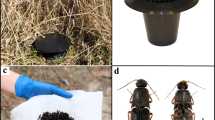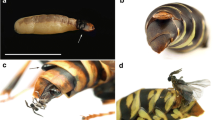Abstract
A new pheromone component, lanierone, (2-hydroxy-4,4,6-trimethyl-2,5-cyclohexadien-1-one) was isolated and identified from a Porapak Q collection of volatiles from maleIps pini from New York through GC fractionation, bioassay, and spectrometry. In both the laboratory and the field, synthetic lanierone, in a 1:100 ratio with synthetic ipsdienol, is as attractive as natural pheromone sources. Synthetic ipsdienol alone is not attractive in the laboratory and only weakly attractive in the field. Varying the ratio of lanierone to ipsdienol in the field from 10−4∶1 to 1∶1 in 10-fold increments resulted in an increased number of beetles trapped at the three lower ratios, but also in an increase in the proportion of males trapped. In the field, all combinations of lanierone to ipsdienol attracted proportionately fewer males than did pheromone-producing male beetles. GC and GC-MS analyses of Porapak Q-trapped volatiles revealed that lanierone is produced in an amount equal to about 0.2% of that of ipsdienol and is produced exclusively by males. The small amount of lanierone produced, together with a GC retention time similar to that of ipsdienol on a nonpolar column, probably confounded its detection in earlier studies.
Similar content being viewed by others
References
Birch, M.C., Light, D.M., Wood, D.L., Browne, L.E., Silverstein, R.M., Bergot, B.J., Ohloff, G., West, J.R., andYoung, J.C. 1980. Pheromonal attraction and allomonal interruption ofIps pini in California by the two enantiomers of ipsdienol.J. Chem. Ecol. 6:703–717.
Birgersson, G., Schlyter, F., Lofqvist, J., andBergstrom, G. 1984. Quantitative variation of pheromone components in the spruce bark beetleIps typographus from different attack phases.J. Chem. Ecol. 10:1029–1055.
Brownlee, R.G., andSilverstein, R.M. 1968. A micro-preparative gas Chromatograph and modified carbon skeleton determinator.Anal. Chem. 40:2077–2079.
Byers, J.A., Birgersson, G., Löfqvist, J., Appelgren, M., andBergstrom, G. 1990. Isolation of pheromone synergists of bark beetle,Pityogenes chalcographus, from complex insect-plant odors by fractionation and subtractive-combination bioassay.J. Chem. Ecol. 16:861–876.
Byrne, K.J., Gore, W.E., Pearce, G.T., andSilverstein, R.M. 1975. Porapak Q collection of airborne organic compounds serving as models for insect pheromones.J. Chem. Ecol. 1:1–7.
Demole, E.P. 1975. Use of cycloaliphatic compounds as perfumes in foods and drinks.Chem. Abs. 82:394.
Byrne, K.J., Gore, W.E., Pearce, G.T., andSilverstein, R.M. 1975. Porapak Q collection of airborne organic compounds serving as models for insect pheromones.J. Chem. Ecol. 1:1–7.
Demole, E.P. 1975. Use of cycloaliphatic compounds as perfumes in foods and drinks.Chem. Abs. 82:394.
Frimer, A.A., Gilinsky-Sharon, P., Aljadeff, G., Gottlieb, H.E., Hameiri-Buch, J., Marks, V., Philosof, R., andRosental, Z. 1989. Superoxide anion radical (O2 ·−) mediated base catalyzed autoxidation of enones.J. Org. Chem. 54:4853–4866.
Greis, G., Pierce, H.D., Jr., Lindgren, B.S., andBorden, J.H. 1988. New techniques for capturing and analyzing semiochemicals for scolytid beetles (Coleoptera: Scolytidae).J. Econ. Entomol. 81:1715–1720.
Lanier, G.N., Birch, M.C., Schmitz, R.F., andFurniss, M.M. 1972. Pheromones ofIps pini (Coleoptera: Scolytidae): variation in response among three populations.Can. Entomol. 104:1917–1923.
Lanier, G.N., Gore, W.E., Pearce, G.T., Peacock, J.W., andSilverstein, R.M. 1977. Response of the European elm bark beetle,Scolytus mulitstriatus (Coleoptera: Scolytidae), to isomers and components of its pheromone.J. Chem. Ecol. 3:1–8.
Lanier, G.N., Claesson, A., Stewart, T., Piston, J., andSilverstein, R.M. 1980.Ips pini: The basis for interpopulational differences in pheromone biology.J. Chem. Ecol. 6:677–687.
Lindgren, B.S. 1983. A multiple funnel trap for scolytid beetles (Coleoptera).Can. Entomol. 115:299–302.
Mendenhall, W. 1983. Introduction to Probability and Statistics. Prindle, Weber and Schmidt Publ., Boston.
Miller, D.R., andBorden, J.H. 1990. β-Phellandrene: Kairomone for the pine engraver,Ips pini (Say) (Coleoptera: Scolytidae).J. Chem. Ecol. 16:2519–2531.
Miller, D.R., Greis, G., andBorden, J.H. 1990. (E)-Myrcenol: A new pheromone for the pine engraver,Ips pini (Say) (Coleoptera: Scolytidae).Can. Entomol. 122:401–406.
Moeck, H.A. 1970. An olfactometer for the bio-assay of attractants for scolytids.Can. Entomol. 102:792–796.
Silverstein, R.M., Rodin, J.O., andWood, D.L. 1967. Methodology for isolation and identification of insect pheromones with reference to studies on California five-spined ips.J. Econ. Entomol. 60:944–949.
Slessor, K.N., King, G.G.S., Miller, D.R., Winston, M.L., andCutforth, T.L. 1985. Determination of chirality of alcohol or latent alcohol semiochemicals in individual insects.J. Chem. Ecol. 11:1659–1667.
Smith, A.B., III, Belcher, A.M., Epple, G., Jurs, P.C., andLa Vine, B. 1985. Computerized pattern recognition: A new technique for the analysis of chemical communication.Science 228:175–177.
Stewart, T.E. 1975. Volatiles isolated fromIps pini: Isolation, identification, enantiomeric composition, biological activity. MSc thesis. College of Environmental Science and Forestry, SUNY, Syracuse, New York.
Still, W.C., Kahn, M., andMitra, A. 1978. Rapid Chromatographic technique for preparative separations with moderate resolution.J. Org. Chem. 43:2923–2925.
Teale, S.A., andLanier, G.N. 1991. Seasonal variability in response ofIps pini (Coleoptera: Scolytidae) to ipsdienol in New YorkJ. Chem. Ecol. 17:1145–1158.
Vité, J.P. 1967. Sex attractants in frass from bark beetles.Science 156:105.
Vité, J.P., andRenwick, J.A.A. 1970. Differential diagnosis and isolation of population attractants.Contrib. Boyce Thompson Inst. 24:323–328.
Wood, D.L., andBushing, R.W. 1963. The olfactory response ofIps confusus (LeConte) (Coleoptera: Scolytidae) to the secondary attraction in the laboratory.Can. Entomol. 95:1066–1078.
Author information
Authors and Affiliations
Additional information
Deceased.
Rights and permissions
About this article
Cite this article
Teale, S.A., Webster, F.X., Zhang, A. et al. Lanierone: A new pheromone component fromIps pini (Coleoptera: Scolytidae) in New York. J Chem Ecol 17, 1159–1176 (1991). https://doi.org/10.1007/BF01402941
Received:
Accepted:
Issue Date:
DOI: https://doi.org/10.1007/BF01402941




